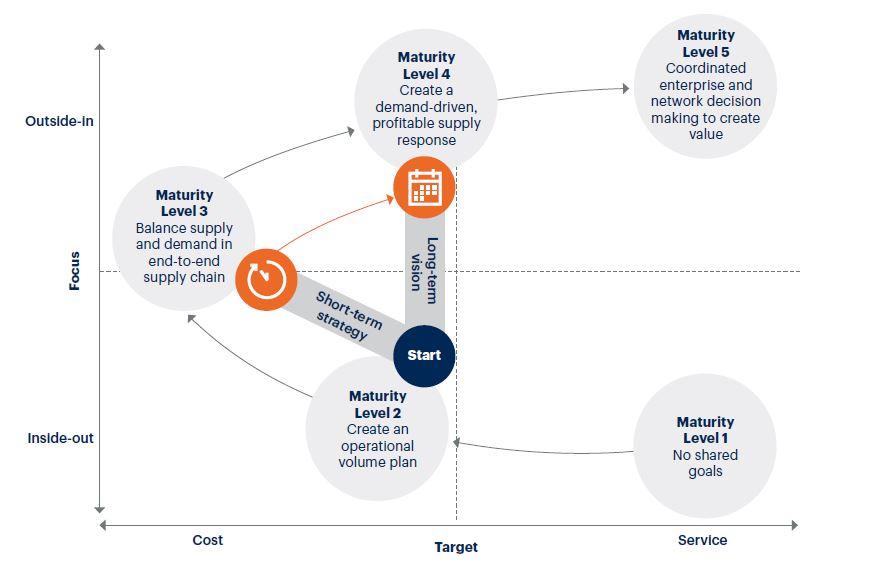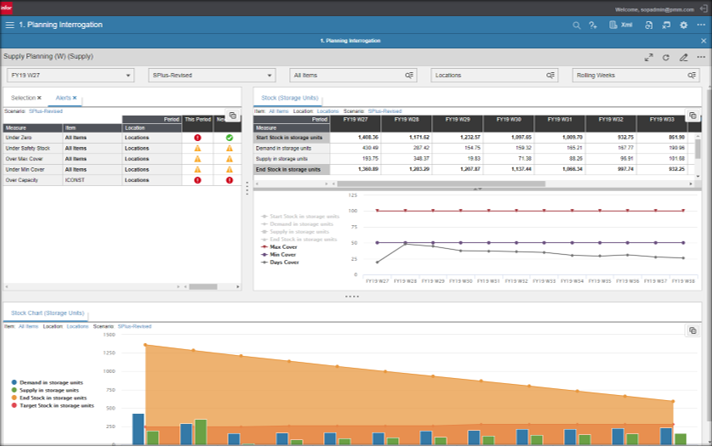The Infor Supply Chain Planning software suite accelerates and orchestrates planning throughout the supply chain. Its IBP — Integrated Business Planning — module simplifies the industrial and commercial planning process ,
Infor IBP is a complete module offering multiple analysis, visualization and collaboration capabilities.
This S&OP software supports the company’s entire strategic process, helping participants to make the right decisions.
The IBP module supports companies in all sectors, bringing them closer to perfect supply chain orchestration.
In addition, Infor IBP enables companies to maintain control over the costs and services provided to their customers:
- link the execution of operations to the company’s strategic objectives
- respond to company challenges and developments by synchronizing objectives and players
- facilitate reactivity with a global process for monitoring the supply chain, particularly in the face of fluctuations and risks

IBP features: industrial and commercial planning software
The IBP module — industrial and commercial planning software — enables …
Long-term planning of demand and supply according to market trends
The S&OP process is fully managed in IBP.
The solution aligns the planning of the company’s various departments with their respective objectives, as well as with the company’ s overall objectives, and thus :
- has a direct and positive impact on the balance of supply and demand,
- participates in improving company processes,
- increases collaboration between players.
What are the consequences of IBP’s balanced long-term vision?
A high-performance planning tool for :
- reduce supply variability,
- absorb fluctuations in demand more easily.
Replace spreadsheets for more reliable data
S&OP processes managed in MS-Excel are time-consuming, and lack transparency and data reliability. And that’s not counting mishandling, which can lead to damaging alterations.
According to the Gartner infographic below, MS-Excel is synonymous with an immature S&OP process:
- little transparency and no collaboration.
If you’re still using spreadsheets for S&OP planning, analysis and reporting, you’re at stage 1 of the maturity model:

The IBP tool, on the other hand, allows you to operate in a network:
- changes made in the system are immediately visible,
- all users can maintain data in this global management system,
- planning is optimized by rolling forecasts based on the most recent data,
- the IBP tool ensures maximum efficiency and guarantees the execution of S&OP processes.
Support your growth initiatives with IBP
Every company encounters and creates business opportunities to be seized. Often, however, decisions can’t be taken calmly due to a lack of concrete means to assess whether launching a new business would affect existing business.
With IBP Integrated Business Planning, corporate decision-makers now have a reliable tool for making the right decisions at the right time:
- monitoring fluctuations in demand,
- simulation and ability to launch new products,
- adapting the Supply Chain to a complex and changing environment,
- all the while ensuring the company’s financial performance.
An integrated, collaborative supply chain with end-to-end operational visibility enhances your organization’s ability to serve its customers and achieve key benefits.
Generate predictive financial analyses, reconciliations andsynchronize your operations
Let’s take 2 services with 2 antagonistic objectives:
- sales plans to optimize revenues,
- while operations are designed to optimize costs.
With their different assumptions and objectives, these 2 services are at odds with each other. They unintentionally lead to a deterioration in the company’s overall performance objectives.
How do you reconcile the KPIs of different departments that clash and contradict each other?
With Integrated Business Planning — IBP, critical data is exposed and synchronized. The tool’s common financial language facilitates management and planning.
Thanks to IBP, you benefit from consistent, shared and clearly presented data.
The S&OP process, and the rigor provided by IBP, ensures the regularity and consistency of business and supply chain planning.
Control your supply chain with “what if” scenario simulations
“Unrealistic planning is as bad as no planning at all”.
Intricate global value chains mean longer lead times. Fluctuating demand and transport conditions make long-term planning extremely complex for companies.
With IBP, multiple “what if” simulations allow :
- project and manage the impact of objectives specific to each department
- and this for all the entities of an organization geolocated throughout the world.
Gone, too, are the“silo” optimizations that dominate corporate planning.
Data and derived objectives are aligned to enable response planning and operational decisions.
Likewise, tactical and strategic planning and decision-making are perfectly aligned with operations.
IBP is a strategic, financial and cross-functional tool, designed to be understood and fed by all participants in your company’s S&OP process.

PIC software implementation: an essential step
On average, ALOER teams and customer teams spend less than 4 months setting up the IBP software.
We strongly recommend change management support for all departments and, more broadly, for all those involved in the IBP project and the company’s S&OP .
A word from the integrator about IBP
Process alignment
S&OP software brings together all the best practices.
Easily configurable, it can be adapted to each organization’s S&OP process.
The software takes care of all the key steps such as :
- demand planning,
- supply planning,
- financial reconciliation
- and executive review.
The software adapts efficiently to the specific workflows and decision-making requirements of each organization.
Scenario planning and what-if analysis
IBP’s strength lies in its ability to perform scenario planning and simulation analyses that would not be possible with ERP… without altering any data.
Infor IBP supports the creation and evaluation of alternative planning scenarios.
For users, it’s finally reassuring to be able to simulate the impact of changes:
- request,
- of supply,
- or commercial variables.
Centralizing all data saves real time in the S&OP process.
Reporting and performance measurement
For ALOER, IBP’s strength lies in its ability to generate numerous standard reports, simplifying analysis.
Tailor-made reports are also easy to create.
Centralized data provides visibility on key metrics, performance trends and exception alerts to support decision-making based on the latest available information.
10 benefits of Integrated Business Planning — Infor IBP
With IBP :
Ensure alignment between departments
Sharing information from sales, operations, finance and supply chain departments in a single tool encourages collaboration and the alignment of everyone’s objectives towards a common goal.
Make informed decisions
Consolidating data from multiple systems and departments is invaluable for decision-makers.
IBP provides a comprehensive, long-term view of the organization, its performance and finances.
This view enables you to make decisions based on the most comprehensive information available, and to better manage risks.
Improve your forecasts
Using data from forecasting software such as Demand Planning, IBP enables you to project revenues and resource schedules .
Optimize your resource allocation
IBP provides greater visibility of available resources, capacity utilization and sales forecasts.
This helps to allocate correctly, avoid bottlenecks, optimize overall productivity and reduce costs.
Synchronize your workflows and processes
Eliminating the need for manual data entry to feed the S&OP process with IBP ensures :
- a significant reduction in errors,
- improving and standardizing process operation,
- automate workflows and reduce the time allocated to the S&OP process.
Project your financial performance
IBP’s numerous dashboards make it easy to visualize and share performance data .
The presentation of past, current and projected revenues, costs and profitability to decision-makers is harmonized.
Access dashboards and data in real time
IBP is a scenario visualization and simulation tool.
It facilitates :
- the study of several situations,
- Measuring progress against initial targets.
Facilitate collaboration and communication
By centralizing data, the S&OP process becomes transparent.
The data used comes from the systems of the various departments involved in the S&OP process.
“Gone are the discussions about the validity of the data, in favor of a real focus on the proposed scenarios and their concretization.”
Scalable software that can be adapted to any situation
IBP, like all the other modules in the Infor Supply Chain Planning suite, adapts to increasing data volumes and organizational changes.
Create a competitive advantage with IBP
The monthly S&OP process is a vector of considerable competitive advantage for the company.
IBP adds another level of maturity to S&OP, notably finance, by integrating the notions of cost, revenue and margin forecasts into the process .
With these best industrial practices, we observe :
- organizations that are more agile and responsive to market changes,
- the relevance of decisions/guidelines facilitated by greater financial integration,
- integrating strategic initiatives into long-term plans,
- broader simulation capabilities, especially budgetary,
- easy transition from aggregate to detailed level,
- greater confidence on the part of management teams, facilitating decision-making.
Discover Infor’s benefits in figures
Infor estimates the benefits:
- to 30 days: the reduction of physical inventory holding time,
- a 5% reduction in shipping costs thanks to better upstream visibility and planning.
